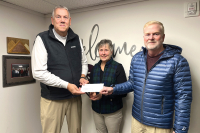Winged wonder: Bird study gets up close with WNC’s avian residents

Cloud cover keeps the summer morning cool as Mark Hopey makes the rounds below Cowee Mound. By 8:30 a.m., he and his two wildlife technicians have already been working at the Franklin-area site for nearly three hours, making hay while the sun doesn’t shine — or at least doesn’t shine with the heat it will gather soon.
Hopey glances down a small trail leading to a net — higher than his head, wide as a volleyball net and strung with fine black netting — before walking on past. No birds there, but he’ll inspect it closer on the way back, just to make sure.
There’s nothing at the second net, either, but just as he approaches the third a pair of feathery black-and-white bodies spiral straight into it, simultaneously snared by the dark weave.
“Wow, that’s not something you see every day,” Hopey remarks.
They’re black-and-white warblers, he declares, pulling a brown paper lunch bag — the empty bag is devoid of lunch — out of his back pocket and marking it in black sharpie to note the time, location, sex and species of the bird in question. Then he reaches for the net, gently untangling the closest warbler from the netting. He places the bird in the bag, twists the top shut, and stows it in a fold of the net while he repeats the process with the second warbler and an indigo bunting that’s been caught at the other end of the net.
Feathers flutter against the brown paper as Hopey walks back down the path, toward the fold-up table that acts as a workstation for his team. He compares notes with the two technicians, who are as impressed with the story of the two warblers simultaneously hitting the net as Hopey was when he witnessed the event. But there’s not much time for chatting. Between the three of them, they’ve collected five birds that must be banded, measured and inspected for a host of data ranging from feather condition to body fat before the timer goes off, declaring that it’s time to release the birds and check the nets once more.
Related Items
Nets are to be inspected on a constant half-hour cycle during the six or so hours the team is out each day, a requirement that, like nearly every other detail of the undertaking, is outlined higher up the food chain by the folks at the California-based Institute for Bird Populations.
Monitoring a community
The bird banding study, which Hopey’s been involved with for six years, is referred to as MAPS — Monitoring Avian Productivity and Survivorship — and is actually a continent-wide study that’s been going on since 1989, comprising 1,200 stations in most states and Canadian provinces.
Hopey, director of the nonprofit Southern Appalachian Raptor Research, got interested in MAPS as a way to help build a detailed picture of migratory bird populations, the way they interact with their habitats and challenges to their success. Mainspring Conservation Trust contracts with him to complete the work, funding the endeavor through a grant from the Cherokee Preservation Foundation. MAPS protocol demands at least eight samples from each site in the spring and summer months. With four sites to monitor in locations ranging from Madison County to Clay County, Hopey’s summers are filled with fieldwork.
“Every other day we’re out here, almost,” he said.
But he doesn’t mind. It’s hard to complain when your office is outdoors among fields, flowers and singing birds, and Hopey’s come to believe strongly in the MAPS project and the power of the data it collects. There are plenty of bird population studies out there that rely on at-a-distance observations through binoculars, which of course is a lot more comfortable for the birds. But this kind of hands-on study allows the team to collect a range of information that would be difficult to determine otherwise.
“This type of study gives me information from each bird,” Hopey said. “Not only species, age and gender, but it gives condition, which is a big part of looking at how the community of birds is doing.”
The data sheet notes the state of the bird’s various types of plumage, how much fat it carries, whether it’s in breeding mode and plenty of other points.
The netting approach also makes it easier to prove how many of which birds are there. If a captured bird doesn’t have a band on its leg, then the team knows it’s an individual they’ve never seen before. That’s a lot different than binocular-based observations, when it can be hard to tell whether that towhee singing in the oak tree is the same bird you heard five minutes ago or a different one.
“When you take the time to set up traps, you’re going to get information you’ll never get by listening and looking,” Hopey said.
For instance, one year at the Tessentee banding site in Macon County, one-third of the birds captured were indigo buntings — a pretty abnormal proportion, but the next year observations switched to a more typical mix. Similarly, one year 146 of the 202 birds banded at the Big Bald site in Madison County were slate-colored juncos.
“It was new to me that it happens quite a bit on a scale we’re not really aware of,” Hopey said.
But despite having six years of intense observation under his belt, Hopey’s loath to speculate on trends and changes in the bird populations he studies. Part of that is because MAPS is such a big study, and he’s not the guy in charge of crunching numbers and drawing conclusions. And part of it is because many of the bird species passing through the banding stations aren’t permanent residents. They’re migrants who come all the way from their wintering grounds in Central and South America to breed in the Southern Appalachians — in the course of 3,000 miles, there are plenty of variables impacting populations that have nothing to do with what’s going on in Western North Carolina.
Those who are tasked with analyzing the data have written hundreds of scientific papers on their findings, with IBP reciting the three main findings from the years of study on its website: survival rates of young birds can be as important as productivity to population change; conditions on wintering grounds and migration routes can carry over to affect birds the following summer; and weather can have a huge impact on success.
The thought is that the conglomeration of data will lead to better understanding of the birds’ challenges and inform how best to address those challenges.
Emphasis on education
Data collected in Western North Carolina will help with the overall effort to understand and bolster bird populations, but for his part, Hopey places much of his focus on impacting the people around him.
“For me at least, it’s about getting kids out here to appreciate the complexity and wonder of what’s around them,” he said, “rather than just seeing it on a screen or at a zoo.”
The more people come out and see bird banding in action, he reasons, the more people will value wildlife and the habitat it needs to stay healthy.
“Good God, it’s the most undervalued thing in the country,” he said.
Southern Appalachian Raptor Research publishes all its MAPS field dates online, welcoming anyone — regardless of experience level — to come out for the morning. The organization also hosts a smattering of kid-oriented field days throughout the year. It’s pretty amazing to come face-to-face with striking birds like cedar waxwings or indigo buntings, and the team is always looking to share the wonder.
That’s what got Lisa Marie Norvill, one of Hopey’s two field technicians, interested in the project. Originally from Queens, New York, Norvill came to Western North Carolina to study fisheries and wildlife management at Haywood Community College. While a student, she did some volunteer work with SARR and jumped at the chance to get a paid job with the organization.
“I just fell in love with bird banding,” she said. “I had never seen this type of thing before.”
The privilege of getting to wake up in the morning and hold such a variety of beautiful birds in her hand isn’t something Norvill takes for granted. She takes joy in getting to know each bird, the personality that accompanies each species.
“Every single bird is a little bit different,” she said. “You get to know them personally by doing this, which is a real treat.”
Growing up the New York City metropolis, wildlife and the natural places it inhabits were far away. In fact, Norvill’s interest in birds grew from the fact that they’re one of the few natural sights you can see when looking through the window over a city block.
Keeping birds around, she believes, is key to maintaining wonder in the world and also to spurring humanity forward — we still have plenty to learn, she said, from watching the birds.
“Birds are an animal that can do the one thing we can’t do, ever,” she said. “We can make planes, but we can’t fly.”
Take a bird in the hand
Getting an up-close look at the birds whose feathers and songs decorate the forest can be a rare treat, but an ongoing volunteer opportunity offers the chance to do just that.
Southern Appalachian Raptor Research spends much of every summer capturing songbirds, taking data on their size and condition, and releasing them back into the air. Volunteers are needed to help the scientists out and get an inside look at how the research works.
Dates remaining for this summer are:
- Thursday, July 28, at Tessentee Bottomland Preserve in Macon County.
- Saturday, July 30, at Cowee Mound in Macon County.
- Sunday, July 31, at Big Bald Banding Station in Madison County.
- Wednesday, Aug. 3, at Welch Farm in Clay County.
- Saturday, Aug. 6, at Tessentee Bottomland Preserve in Macon County
- Sunday, Aug. 7, at Tessentee Bottomland Preserve in Macon County.
- Tuesday, Aug. 9, at Big Bald Banding Station in Madison County.
Sampling runs from 6 a.m. to noon each day, with volunteers welcome for any or all of that timeframe. Dates are subject to change based on weather, so RSVPs are important. Directions to banding locations are on the SARR website.
In addition to hosting individual volunteers, SARR also does free educational programs by request at its data collection sites.
SARR’s breeding bird monitoring work is funded by Mainspring Conservation Trust through a grant from the Cherokee Preservation Foundation. Other sponsors of the work include the Eastern Band of Cherokee Indians, the Franklin Bird Club and the Highlands Plateau Audubon Society.
Mark Hopey, 828.736.1217 or This email address is being protected from spambots. You need JavaScript enabled to view it.









